Indoor air quality is something that many of us take for granted, but the truth is that it is a significant factor in our health and well-being. Poor air quality can lead to various respiratory illnesses, allergies, and other issues. One of the best ways to improve indoor air quality is by installing single room heat recovery. These are the reasons why single-room heat recovery is beneficial for improving indoor air quality. Read on to find out more about this highly effective air quality solution!
What Is Single-Room Heat Recovery?
Single-room heat recovery, also known as a single-room heat recovery ventilator (HRV), is a system that improves indoor air quality by providing ventilation and heat exchange in individual rooms. Unlike a whole-house HRV system, designed to provide ventilation for an entire building, a single-room HRV specifically serves one room or a small area.
The single-room HRV extracts stale, moist air from the room and replaces it with fresh, filtered air from the outside. It achieves this by utilizing a heat exchange core that transfers the heat from the outgoing air to the incoming air, reducing the energy needed to heat or cool the room. This heat exchange process also helps to prevent condensation and dampness, which can lead to mold and mildew growth.
One of the key benefits of a single-room HRV is its ability to enhance comfort and temperature control in a specific room. By continuously exchanging the air, the HRV helps to maintain a constant temperature and removes any hot or cold spots, ensuring a more comfortable environment for occupants.
Small Heat Recovery Ventilator Improves Ventilation And Air Quality
One of the significant benefits of using a small heat recovery ventilator (HRV) is its ability to improve ventilation and air quality in a single room. Traditional ventilation systems often circulate stale air throughout the entire building, but with a small HRV, you can specifically target and control the air quality in a particular space.
The small HRV extracts stale air from the room and replaces it with fresh, filtered air from outside. As the thick air is expelled, the HRV transfers the heat from the outgoing air to the incoming fresh air, ensuring no significant loss of warmth. This not only helps in maintaining a comfortable temperature but also minimizes energy wastage.
Moreover, the small HRV effectively filters the incoming air, removing pollutants, allergens, and other contaminants. This is especially crucial for people with allergies or respiratory conditions as it provides a constant supply of clean and fresh air, free from airborne irritants.
Reduction Of Energy Consumption
One of the major benefits of single-room heat recovery is that it significantly reduces energy consumption. By utilizing the heat that would typically be lost during ventilation, a single-room heat recovery ventilator can decrease the energy required to heat or cool a room.
For example, during the winter, when the indoor air is heated, it will become stale and moist. Without proper ventilation, you would need to use a lot of energy to circulate the indoor air. But, with a single-room heat recovery ventilator, you can extract the heat from the outgoing stale air and transfer it to the incoming fresh air. This means that you do not have to use as much energy to reheat the fresh air as you would otherwise.
This not only benefits the environment by reducing carbon emissions, but it also saves money on utility bills. By using less energy, you can reduce your heating and cooling costs, which will lead to long-term savings and a quick return on investment (ROI).
Single Room Heat Recovery Ventilator Enhance Comfort And Temperature Control
One of the significant benefits of single room heat recovery ventilator is its ability to enhance comfort and temperature control. With a heat recovery ventilator in place, you can enjoy a steady supply of fresh air, which in turn keeps the indoor temperature at a desirable level.
Unlike traditional heating and cooling systems, which often struggle to maintain a comfortable indoor temperature, single-room heat recovery provides an effective way of regulating the temperature and maintaining a consistent level of comfort.
The ventilator is designed to recycle air from your room, meaning that it captures and uses the energy from the outgoing air to heat or cool the incoming air, depending on the season. This results in a significant reduction in the need for additional heating and cooling systems, thereby reducing energy consumption and costs.
Moreover, a single-room heat recovery ventilator offers more control over your indoor climate, as it allows you to adjust the temperature according to your preference. With this level of temperature control, you can enjoy a comfortable indoor environment throughout the year.
Prevention Of Condensation And Dampness
One of the key benefits of using a single-room heat recovery ventilator (HRV) is its ability to prevent condensation and dampness. In traditional heating and ventilation systems, condensation can occur when moist air comes into contact with a cold surface. This can lead to water, which can be damaging to both the building structure and the health of its occupants.
However, with a single-room HRV, moisture-laden air is extracted from the room and transferred to the outside, while fresh air is simultaneously drawn in and heated to room temperature. This constant exchange of air ensures that there is no build-up of moisture in the room, which in turn helps prevent condensation and dampness.
Single Room Hrv Reduce Odors And Pollutants
One of the biggest benefits of a single room hrv is its ability to reduce odors and pollutants in the air. These pollutants can come from a variety of sources, such as cooking, cleaning products, and pet dander. When left unchecked, they can cause respiratory problems, allergies, and other health issues.
By using a single-room HRV, the air in a room is continuously refreshed, reducing the concentration of pollutants and odors. The HRV system pulls in fresh air from outside, filters it to remove impurities, and then sends it inside. At the same time, stale, polluted air is extracted from the room and expelled outside.
This process ensures that the air in the room remains clean and healthy. And because the HRV is specifically designed for a single room, it can target areas of the house where pollutants are most concentrated.
Health Benefits
One of the significant advantages of using single-room heat recovery (HRV) systems is the positive impact on health. These systems play a crucial role in improving indoor air quality by removing contaminants and maintaining a healthy environment.
First and foremost, single-room HRV systems effectively remove allergens such as pollen, dust, and pet dander from the air. This is particularly beneficial for individuals who suffer from allergies or asthma, as it can help alleviate symptoms and improve breathing.
Furthermore, these systems can also eliminate harmful pollutants, such as volatile organic compounds (VOCs) and carbon monoxide, which can have detrimental effects on our health. VOCs are often emitted from household cleaning products, paints, and furnishings, and prolonged exposure to them can lead to respiratory issues and other health problems.
In addition to reducing allergens and pollutants, single-room HRV systems also help control humidity levels. Excess moisture in the air can create a breeding ground for mold and mildew, which can have adverse effects on respiratory health. By maintaining proper humidity levels, these systems help prevent the growth of these harmful substances and promote a healthier living environment.
Cost Savings And ROI
Investing in a single-room heat recovery system not only has a positive impact on the environment and health, but it can also save you money in the long run. By reducing energy consumption, these systems can significantly lower your utility bills. With less heat lost through ventilation, your heating system will work more efficiently, using less energy to maintain a comfortable temperature. This is particularly beneficial in the colder months when heating costs are high.
Additionally, the prevention of condensation and dampness can save you money on repairs for moisture-related damage, such as mold growth or rotting of building materials. By improving the air quality in your home or business, single-room heat recovery systems can also reduce the likelihood of respiratory illnesses, leading to fewer medical bills and absences from work.
Conclusion
In conclusion, single-room heat recovery is a revolutionary technology that can greatly improve indoor air quality. By using heat recovery ventilators, homeowners can ensure proper ventilation and filtration of incoming air, reducing the presence of pollutants and allergens. Not only does this result in a healthier living environment, but it also enhances overall comfort and temperature control.
Additionally, single-room heat recovery systems help prevent condensation and dampness, which can lead to the growth of mold and mildew. This not only protects the structural integrity of a home but also contributes to the overall well-being of its occupants.
Furthermore, by reducing energy consumption, single-room heat recovery can lead to significant cost savings over time. The initial investment in these systems can be offset by long-term energy savings and increased efficiency.
| Other Good Articles to Read |
| Skank Blogs |
| Unreal Blogs |
| Tba Blogs |
| All City Forums |
| Dany Blogs |
| Refuge Blogs |
| The Music Blogs |
| Key Forums |
| The Big Blog Theory |
| Joe Blogs |
| Blogs 4 Me |
| Blogs Emon |

